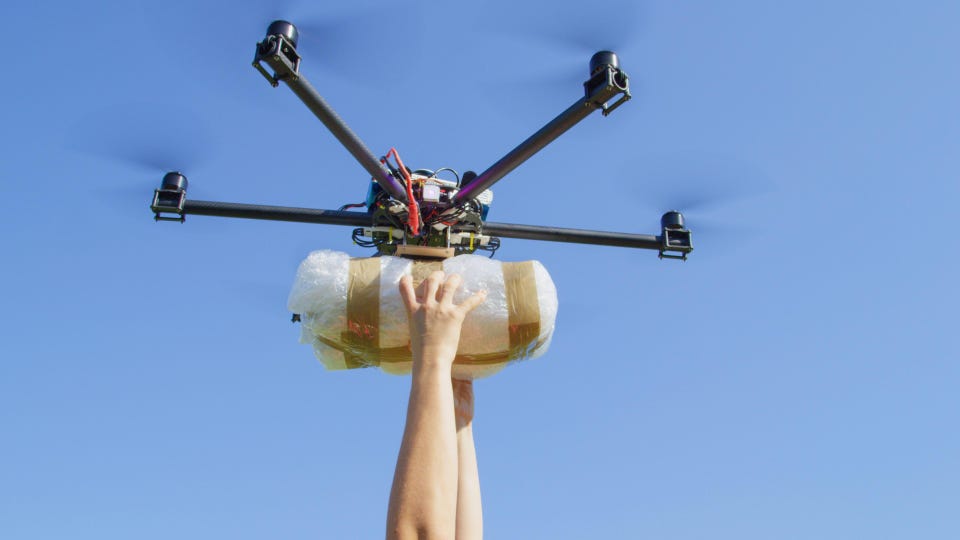It Looked Like A Nice Family Home. Cops Suspect It Was A Secret Drone Airport For MDMA Dropoffs.

Share to FacebookShare to TwitterShare to Linkedin
Drones are being used to bring drugs into even the more affluent parts of America, cops find.
getty
Drone surveillance helped cops find a potential entry point for banned substances into America in one of the country’s more affluent areas.
The neighbors thought it odd that no one seemed to live in the capacious, quintessential American family house in Lewiston, New York, a small town that sits on the Niagara River, just east of Ontario, Canada. Whoever owned the $650,000 property appeared neither to reside there nor care about upkeep, its lawn unmowed to the point of being “unmanageable,” locals later told police. Even odder, they told the cops, were the monthly arrivals of individuals driving expensive-looking cars, only for the visitors to leave a few days later.
Then in the early hours of September 21 last year, the house became the subject of a police raid, according to a recently unsealed search warrant obtained by Forbes. In the middle of the night, using a surveillance tool that could “recognize drone signatures, map their flight path and identify starting and stopping points via GPS,” border patrol watched an unmanned aerial vehicle flying over the Niagara River and into the house’s garden, according to the warrant. When the cops arrived, the pilot and two other individuals tried to flee, but were caught and taken in for questioning. The police found that attached to the drone was a package of MDMA with an approximate street value of $110,000. A subsequent search of the house recovered multiple webcams watching over entrances and exits, a number of commercial drones and paracord, a kind of rope originally designed for parachutes.
The case reveals the government’s investment in drone surveillance, in particular at the border. “The border entities are much better at it,” said Mary-Lou Smulders, chief marketing officer at drone detection contractor Dedrone, a provider to various U.S. federal government agencies.
The investigators in the Niagara River probe likely used radio frequency signals to tag and track the unmanned flying vehicle, Smulders said. That involves setting up sensors across a given area, and triangulating the drone’s signals to get a relatively precise location. There are other ways to monitor drones, however, from radar to listening for the machines’ noises using arrays of microphones.
Simple users in drugs and narcotics are not known to import the drugs themselves using highly sophisticated smuggling methods such as a drone…
The Department of Homeland Security
While such high-tech tools can identify aerial devices potentially being used for illegal means, old fashioned policing is still required to establish any definitive breach of the law. One of the suspects in the Niagara Falls case told police he worked at a nail salon in Long Island. When the police checked property records, they learned that the same business — owned by the suspect’s sister — bought the Lewiston house for $630,000 in April 2022.
But rather than doing anything nefarious, the suspect claimed he’d met his fellow suspects playing online games and had organized a holiday with them at the property because he needed “rest and relaxation” after being diagnosed with kidney stones, according to the search warrant. The suspect said he believed the drone had arrived at the property prior to his arrival and that it was used to play some sort of online game.
According to the cops, though, the home didn’t appear ideal for recuperation. The search warrant described it as “predominantly unfurnished” with the exception of a couch, some mattresses and blow-up beds. “There was no home décor such as artwork or photographs within the residence. There were no typical food supplies or any typical household items which would establish that anyone used the residence as a primary or ‘everyday’ residence,” the cops wrote.
In a charging document for one of the apprehended, a Department for Homeland Security agent noted it was also unlikely the 3.1KG of MDMA found attached to the drone was for personal use. “Those who use MDMA in party and casual settings do not typically buy MDMA in the kilogram amount,” the investigator wrote. “Additionally, simple users in drugs and narcotics are not known to import the drugs themselves using highly sophisticated smuggling methods such as a drone.”
Only one of the suspects, the alleged drone pilot Edvin Yug Deng, has been charged so far. He entered a plea of not guilty, but has been placed on home detention with electronic monitoring as he awaits trial. His counsel hadn’t responded to a request for comment at the time of publication. As the other suspects who were allegedly at the house have not been charged, Forbes is not publishing their names. Neither the Justice Department nor Customs and Border Protection responded to requests for comment.
Dedrone’s Smulders said that more investment may be needed at police departments in inland America for better identification of illegal drone use. “There are a couple of police departments across the U.S. that you see in drug detection and identification that are sort of leading the way,” she added. “But the truth is, [drones] are a brand new technology that people are trying to figure out, for good and for bad.”
